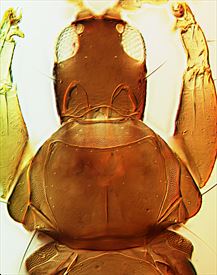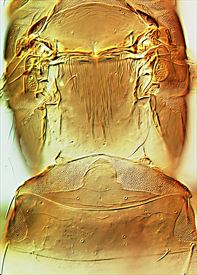Distinguishing features
Female macroptera. Body brown, tarsi, fore tibiae, and extreme base of antennal segment III yellow; fore wings shaded, darker in basal half; major setae pale. Head longer than wide, sculptured near base; cheeks rounded, constricted at base; posterior pair of ocelli close to margin of compound eyes; postocular setae acute, low on head, almost halfway between base and compound eyes; maxillary stylets about one-fifth of head width apart, retracted to postocular setae; maxillary bridge faintly indicated. Antennae 8-segmented; segment II with campaniform sensillum in basal half of segment; III with 2 long, stout sense cones, IV with 3 similar sense cones; VIII elongate. Pronotum shield-like, with a median line; epimeral setae long, pointed, remaining setae short; epimeral sutures complete; basantra absent. Mesonotum sculptured on anterior half; mesopresternum reduced to 2 small lateral plates. Metanotum with striate reticulations, a pair of pores, and a pair of setae medially; metathoracic sternites heavily eroded almost halfway to hind coxae. Fore tarsal tooth large; middle tibiae each with an apical spur-like seta; hind tibiae with 1 large and 1 small spur-like setae. Fore wing parallel-sided, with 3–7 duplicated cilia, 1 long major sub-basal seta, and a smaller seta posteriorly. Pelta with 2 large lateral lobes; tergite II heavily eroded laterally. tergite IX posteromarginal setae acute; tube stout, shorter than head, constricted at apex. Sternite VI with a characteristic worm-like reticulate area, this area reduced on sternites V and VII.
Male not known.
Related species
The genus Plectrothrips occurs throughout tropical countries and comprises 32 species, all apparently fungus-feeding on dead branches. The specimens from New Zealand identified as P. orientalis are smaller than the smallest available paratype of that species, with shorter antennal sense cones and less clearly defined reticulate areas on the median sternites, but they cannot be distinguished from a small female of orientalis that was collected more recently in Singapore.
Biological data
Living on dead branches and presumably feeding on fungal hyphae or their break-down products.
Distribution data
Described from Singapore, and West Malaysia, and recorded from Japan, Philippines, Hawaii, and New Zealand (AK / SD, NN).
Family name
PHLAEOTHRIPIDAE, PHLAEOTHRIPINAE
Species name
Plectrothrips orientalis Okajima
Original name and synonyms
Plectrothrips orientalis Okajima, 1981: 327
References
Mound LA & Walker AK (1986) Tubulifera (Insecta: Thysanoptera). Fauna of New Zealand 10: 1–140.


